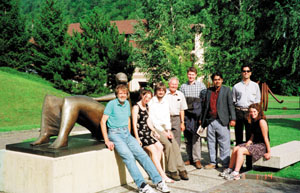
In July 1994 Swedish musical personality Martin Engstrom launched the Verbier Festival and Academy in Valais, Switzerland, which has gone on to become a regular feature of the late-July arts calendar. This festival has attracted prominent figures from the musical and theatrical world, such as Zubin Mehta, Isaac Stern and Isabelle Huppert. It is now a valuable step on the ladder for aspiring young artists.
CERN physicist André Martin and his wife Schu knew Aspen, in the Rocky Mountains, where there is a very successful annual summer symbiosis of music, mountains and physics, with the famous Music Festival on one hand and the Aspen Center for Physics on the other. It was tempting to propose scientific activities in conjunction with the Verbier Music Festival.
In the summer of 2000 this was realized for the first time through a conference entitled CAPP (Cosmology and Astroparticle Physics) 2000, organized by Ruth Durrer, Juan Garcia-Bellido, André Martin and Misha Shaposhnikov. About 100 participants came from as far afield as Australia and Korea, to Verbier’s “Centre Culturel du Hameau”.
Prestigious lecturers also came from all over the world. The programme covered both theoretical and experimental physics. One focus was the extremely accurate measurements of the structure of cosmic microwave background radiation by the balloon experiments Boomerang and Maxima at the South and North poles, respectively. This, combined with new measurements of the Hubble galactic recession parameter, leads to a picture of the universe which is asymptotically flat (W = 1), with an accelerating expansion, a non-vanishing cosmological constant and an age of between 14 and 18 billion years, fitting most inflationary models.
W = 1 is the result of W = 0.3 for matter and 0.7 for the vacuum. The former retains a need for invisible “dark matter”, also needed to explain the observed rotation of galaxies. Although definite cases of gravitational lensing have been seen (see Not enough stellar mass objects to fill the galactic halo?), their interpretation does not seem to fit with the Massive Astronomical Compact Halo Object (MACHO) picture.
On the other hand the Weakly Interacting Massive Particle (WIMP) interpretation of dark matter is still possible, which would also be an indication in favour of supersymmetry.
Among the projects for the future, more refined detectors of the cosmic microwave background such as the Planck mission and the Virgo project for detecting gravitational waves were described. Tremendous progress has been made in recent years thanks to the new instruments, and this looks set to continue. In particular the continued detailed analysis of fluctuations in the cosmic microwave background radiation will lead to a further confirmation of the inflationary models.
Returning to the music festival, a public lecture “L’Univers, passé, présent et futur” given in “Café Schubert” (where musicians attending the festival are habitually interviewed), was well received by an audience including Swiss Federal Councillor Pascal Couchepin.







